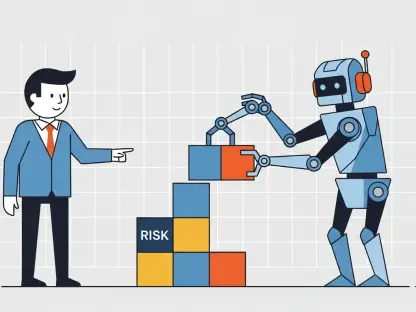The trucking insurance industry stands at a crossroads, where the integration of artificial intelligence (AI) is rewriting the rules of risk assessment, premium pricing, and claims management. Gone are the days when insurers depended solely on outdated manual processes and broad assumptions about entire fleets; instead, cutting-edge technology is harnessing real-time data to create a more precise and equitable system. From telematics to dashcams, the wealth of information now available offers an unprecedented glimpse into a fleet’s day-to-day operations, paving the way for tailored solutions that benefit both insurers and trucking companies. This technological leap is not just a trend but a fundamental shift, promising enhanced safety, reduced costs, and streamlined efficiency across the board. As the industry adapts to these innovations, the potential for a safer and more competitive landscape emerges, driven by data that reflects reality rather than guesswork.
Revolutionizing Risk Assessment and Pricing
Shifting to Individualized Models
The traditional approach to underwriting in trucking insurance often relied on grouping fleets into broad categories, a method that frequently disadvantaged safer operators by forcing them to bear the burden of riskier peers. AI is upending this model by tapping into real-time data from technologies like electronic logging devices (ELDs) and advanced driver assistance systems (ADAS). This allows insurers to evaluate each fleet based on its specific performance metrics, such as driver behavior and vehicle maintenance patterns. The result is a pricing structure that mirrors actual risk levels, ensuring that companies with strong safety records are not unfairly penalized. This granular approach not only promotes fairness but also drives a cultural shift within the industry, encouraging all players to prioritize safety and operational excellence as a direct path to financial savings.
Moreover, the shift to individualized pricing has tangible economic impacts for trucking companies striving to maintain high standards. Industry insights suggest that fleets adopting robust safety practices could see premium reductions of up to 20%, a significant margin in an industry where every dollar counts. Beyond cost benefits, this data-driven method fosters transparency between insurers and clients, as premiums are no longer shrouded in generalized assumptions but are instead tied to verifiable metrics. The ripple effect is a marketplace where competition is fueled by accountability, pushing even the most risk-prone fleets to invest in technology and training to secure better rates. This transformation underscores how AI is not merely a tool but a catalyst for systemic change in how risk is understood and managed.
Incentivizing Safer Operations
AI’s ability to personalize insurance pricing extends beyond mere numbers; it actively incentivizes safer operations across the trucking sector. With real-time data feeding into underwriting algorithms, fleets are motivated to implement stricter safety protocols, knowing that their efforts will be directly reflected in lower premiums. For instance, consistent use of dashcams to monitor driver behavior or telematics to track speeding incidents can translate into measurable improvements in a fleet’s risk profile. Insurers, in turn, reward these proactive measures, creating a feedback loop where safety becomes a strategic priority rather than an afterthought. This dynamic is reshaping fleet management practices, aligning business goals with broader industry objectives of reducing accidents and enhancing road safety.
Additionally, the emphasis on safety through AI-driven insights helps cultivate a culture of continuous improvement among trucking companies. As data highlights specific areas of concern—whether it’s harsh braking patterns or frequent lane departures—fleet managers can address issues in real time through targeted driver coaching and training programs. This not only mitigates immediate risks but also builds long-term resilience against potential liabilities. The financial incentive of reduced premiums acts as a powerful motivator, encouraging even smaller fleets with tighter budgets to adopt advanced technologies. Over time, this trend promises to elevate safety standards industry-wide, proving that AI’s influence extends far beyond the balance sheet to the very core of operational ethos.
Enhancing Operational Efficiency
Automating Routine Processes
One of the most immediate benefits of AI in trucking insurance lies in its capacity to automate routine processes, significantly boosting operational efficiency for providers. Tasks such as generating claim summaries, processing paperwork, and navigating dense underwriting manuals can now be handled by intelligent systems, reducing the time spent on repetitive work. This automation enables insurance staff to shift their focus toward more complex and value-driven activities, such as crafting tailored policies or addressing client concerns. By streamlining these mundane aspects, AI ensures that the workflow within insurance companies becomes more agile, ultimately translating into faster response times and improved service quality for trucking clients seeking coverage or claims resolution.
Furthermore, the impact of automation extends to cost management within insurance firms, allowing them to allocate resources more effectively. With AI taking on data-intensive tasks, human employees are freed up to engage in strategic planning and relationship building, which are critical for maintaining a competitive edge in a rapidly evolving market. This efficiency gain is particularly vital in an industry where margins can be tight, and client expectations for quick, accurate service continue to rise. The adoption of AI-driven tools for routine operations also minimizes the likelihood of human error, ensuring consistency in processes like risk evaluation or claim documentation. As a result, insurers can deliver a higher standard of reliability, reinforcing trust with their clients while optimizing internal productivity.
Empowering Human Decision-Making
Far from replacing human expertise, AI serves as a vital ally in empowering decision-making within the trucking insurance sector. By handling the grunt work of data analysis and providing real-time recommendations during client interactions, AI equips underwriters and claims handlers with the insights needed to make informed choices swiftly. This supportive role ensures that complex decisions—such as determining liability in a disputed claim or adjusting a fleet’s risk profile—benefit from both technological precision and human judgment. The synergy between AI tools and professional acumen preserves the personal touch that remains essential in client-facing roles, balancing efficiency with empathy in an often high-stakes environment.
Equally important is how AI enhances the capacity of insurance professionals to focus on strategic priorities that drive long-term growth. With routine queries and data processing managed by algorithms, staff can dedicate more energy to understanding emerging risks, refining pricing models, and fostering deeper connections with trucking companies. This shift not only improves job satisfaction among employees by reducing burnout from repetitive tasks but also positions insurers to adapt proactively to market changes. The result is a workforce that is both more engaged and better equipped to navigate the nuances of an industry increasingly shaped by technology. AI, in this context, acts as a bridge, connecting raw data to actionable strategies while keeping human insight at the forefront of critical decisions.
Mitigating Risks and Legal Challenges
Enabling Proactive Safety Interventions
AI’s integration into trucking insurance is proving instrumental in enabling proactive safety interventions that prevent accidents before they occur. By analyzing real-time data from onboard systems like telematics and dashcams, insurers and fleet managers can identify potential hazards—such as erratic driving patterns or equipment malfunctions—instantly. This allows for immediate driver coaching or corrective actions, significantly reducing the likelihood of costly collisions or injuries. Such preemptive measures not only safeguard lives but also lower the frequency of claims, benefiting both fleets and insurance providers through reduced financial exposure and enhanced road safety.
The broader implications of these interventions are reshaping how safety is prioritized within the trucking industry, with significant impacts on operational standards and driver accountability. With AI providing continuous feedback, fleets can implement training programs tailored to specific weaknesses identified in their data, fostering a culture of accountability among drivers. This ongoing monitoring also helps in maintaining compliance with safety regulations, as potential violations can be addressed before they escalate into penalties or accidents. Over time, the cumulative effect of these proactive steps is a noticeable decline in incident rates, which in turn stabilizes premium costs for fleets that commit to data-driven safety practices. AI’s role here is transformative, turning raw information into a powerful tool for prevention rather than mere reaction.
Combating Fraudulent Claims
Another critical advantage of AI in trucking insurance is its ability to combat fraudulent claims, a persistent challenge in an industry vulnerable to exaggerated lawsuits and high-cost settlements. Real-time data from onboard technologies provides indisputable evidence—such as video footage from dashcams or timestamped logs from ELDs—that can refute false allegations or inflated damages. This hard data accelerates claim resolutions by cutting through disputes with factual clarity, saving fleets and insurers from the financial drain of prolonged legal battles. In an era where “nuclear verdicts” can result in multimillion-dollar payouts, this protective layer is invaluable for maintaining fiscal stability.
Beyond immediate resolutions, the presence of AI-backed evidence serves as a deterrent against fraudulent behavior in the first place. Knowing that claims will be scrutinized with precise, timestamped records discourages opportunistic lawsuits, creating a more honest claims environment. This shift also allows insurers to allocate resources more effectively, focusing on legitimate cases rather than battling unfounded ones. For fleets, the benefit is twofold: reduced legal costs and a stronger defense against reputational damage tied to drawn-out litigation. AI’s contribution in this arena reinforces its value as not just an efficiency tool but a safeguard for the industry’s integrity, ensuring that resources are directed toward genuine needs rather than deceptive tactics.
Addressing Regulatory and Adoption Barriers
Navigating a Complex Regulatory Environment
The adoption of AI in trucking insurance faces significant obstacles due to a fragmented regulatory environment across different states, creating a complex landscape for insurers to navigate. While some regions, such as California and Colorado, have taken the lead in establishing guidelines to prevent bias and discrimination in AI algorithms, the absence of a cohesive national framework creates uncertainty for insurers. This inconsistency forces companies to tailor their AI strategies to comply with varying local rules, slowing the rollout of innovative pricing models and risk assessment tools. The challenge lies in balancing the push for technological advancement with the need to adhere to diverse compliance standards that protect consumers and ensure fairness.
This regulatory patchwork also impacts the pace at which smaller insurers or regional fleets can integrate AI solutions, and without uniform standards, many hesitate to invest in new systems, fearing future adjustments or penalties if state laws shift. The complexity of navigating these disparities often requires legal expertise and additional resources, which can be a barrier for companies with limited budgets. However, as more states recognize the need for clarity in AI governance, there is hope that collaborative efforts will emerge to streamline regulations. Until then, insurers must remain agile, adapting to local mandates while advocating for broader policies that support innovation without compromising ethical standards.
Overcoming Industry Conservatism
The inherently conservative nature of the insurance sector presents another hurdle to widespread AI adoption in trucking insurance. Many established companies are cautious, preferring to test AI applications on a limited scale rather than fully overhauling their operations. This reluctance often stems from concerns over data privacy, algorithmic transparency, and the potential for unintended biases in automated systems. While such caution ensures a measured approach, it can also delay the realization of AI’s full benefits, leaving some insurers at a competitive disadvantage compared to early adopters who embrace a more aggressive integration strategy.
Despite these reservations, gradual progress is evident as the industry witnesses the tangible advantages of AI among pioneering firms. Success stories—such as significant cost savings for fleets and faster claims processing—serve as compelling evidence that encourages even the most hesitant players to explore AI’s potential. Education and collaboration between technology providers and insurance leaders are also key to overcoming skepticism, helping demystify AI and address concerns through transparent practices. As regulatory frameworks evolve to provide clearer guidance, and as trust in AI systems grows, the sector’s conservative stance is likely to soften, paving the way for broader acceptance and deeper technological integration across all levels of the industry.
Envisioning a Data-Driven Future
Transitioning to Essential Technology
Industry experts are increasingly vocal about the trajectory of AI in trucking insurance, asserting that it is rapidly transitioning from an optional enhancement to an essential component of operations. The financial and safety risks associated with operating without advanced data tools are becoming prohibitive, pushing companies to adopt AI-backed technologies like telematics and onboard cameras as standard practice. This shift is driven by the undeniable value of real-time insights, which enable more accurate risk pricing, quicker claims handling, and proactive safety measures. As the competitive landscape tightens, those who fail to embrace this technology risk falling behind, both in terms of cost efficiency and operational resilience.
The urgency of this transition is underscored by the escalating costs of non-adoption, particularly in an industry where margins are often razor-thin, and the need to stay competitive is paramount. Fleets without AI-driven data systems may face higher premiums due to unmitigated risks, while insurers lacking automation struggle with inefficiencies that erode profitability. The momentum toward making AI a baseline requirement is further fueled by client expectations for personalized service and rapid response times, demands that are nearly impossible to meet without technological support. Looking forward, the integration of AI promises to redefine industry standards, establishing a new norm where data-driven decision-making is not just advantageous but indispensable for survival in a fast-evolving market.
Balancing Innovation with Ethical Oversight
As AI becomes entrenched in trucking insurance, the need to balance innovation with ethical oversight grows more pressing, especially since the power of real-time data to transform operations must be tempered by safeguards that prevent misuse. Issues such as biased algorithms or invasions of driver privacy must be addressed. Industry stakeholders are advocating for robust policies to ensure that AI systems are transparent, fair, and accountable, protecting both fleets and their employees from potential discrimination or exploitation. This balance is crucial for maintaining public trust, especially as AI takes on more decision-making roles in underwriting and claims processing, areas where impartiality is paramount.
Achieving this equilibrium requires ongoing dialogue between insurers, technology developers, and regulators to establish best practices that prioritize ethical considerations without stifling progress. Lessons from early-adopting states highlight the importance of proactive measures, such as regular audits of AI models to detect and correct biases. Additionally, educating all parties about the capabilities and limitations of AI fosters realistic expectations and mitigates fears of over-reliance on technology. By embedding ethical principles into the deployment of AI, the trucking insurance industry can harness its transformative potential while upholding the values of fairness and responsibility, ensuring that the benefits of innovation are shared equitably across the board.
Reflecting on a Technological Milestone
Looking back, the journey of AI in trucking insurance marked a pivotal chapter in the industry’s evolution, highlighting a transformative shift in operational and risk management practices. The transition from manual, cohort-based underwriting to data-driven, personalized models addressed long-standing inequities, rewarding safe fleets while encouraging others to elevate their standards. Efficiency soared as AI automated routine tasks, empowering professionals to focus on strategic goals, while real-time insights slashed risks and fortified defenses against fraudulent claims. Despite initial hurdles posed by regulatory disparities and industry caution, the momentum toward adoption gained traction as success stories mounted. Moving forward, the focus should center on refining ethical guidelines and fostering collaboration to standardize AI governance nationwide. By investing in transparent practices and continuous education, the industry can ensure that this technological milestone becomes a lasting foundation for safer, smarter operations, setting a precedent for how innovation and accountability can coexist.









